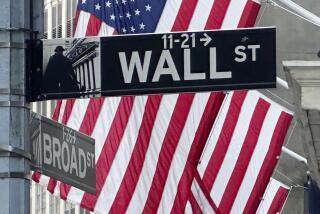Interest rate fears at rest? Don’t get too comfortable
Many Wall Street analysts believe that long-term interest rates in the U.S. aren’t likely to continue the sharp upward move of the last few months. Rates, many say, could stabilize soon, or at worst move gradually higher.
Here are two risks to that forecast:
* Inflation pressures may be more serious than the markets suspect. We all have been taught that inflation is the great boogeyman of financial markets. If inflation is on the rise it will erode the value of stocks, bonds and other assets. The natural response of bond investors is to demand higher interest payments to make up for that erosion risk.
The Federal Reserve has continued to sound the alarm about inflation pressures over the last year, even as it held its benchmark short-term interest rate steady at 5.25%.
Yet the latest data show inflation ebbing in the U.S., at least by some measures. The government’s report Friday on May consumer prices showed that the core inflation index (excluding food and energy costs) rose just 0.1%. The year-over-year gain, at 2.2%, was the smallest in 14 months.
Including all costs, consumer prices were up 0.7% in May, as gasoline soared. But bond investors, for better or worse, focus on the core inflation rate, and that low reading helped push Treasury bond yields down Friday.
If actual inflation isn’t driving interest rates up, maybe it’s fear of where it could be headed. The Fed isn’t alone among central banks in worrying that prices might yet break out. The European Central Bank, the Bank of England and others also have been sounding inflation alarms.
Energy costs remain vexing. Crude oil futures in New York ended Friday at $68 a barrel, the highest level since September.
Still, if investors feared a debilitating upward trend in inflation, some would be running to gold, the classic inflation hedge. Instead, at $654.50 an ounce Friday, gold is down from nearly $700 in April. No sign of inflation panic there, and that should give bond and stock investors some comfort.
* Foreigners may begin to bail out of U.S. securities. This is another boogeyman Americans have been warned about for years. We rely heavily on foreign investors to finance our trade and federal budget deficits. We buy their goods, they buy our bonds.
If they were to begin jettisoning our Treasuries and other bonds, interest rates could surge because the market would have to scramble to find new buyers.
Data from the Treasury Department showed Friday that foreign investors in fact shrank from the Treasury bond market in April, buying less than $400 million net of sales, down from $30.5 billion in net purchases in March. The April figures are the latest available.
Overall, however, foreigners bought a net $97 billion of U.S. bonds and stocks in April, about the same as in March. They simply shifted from Treasuries to other securities.
The bottom line is that “the U.S. is attracting more than enough foreign investment to finance its trade deficit,” said Michael Woolfolk, senior currency strategist at the Bank of New York.
Another sign that there is no wholesale dumping of U.S. bonds by foreigners is that the dollar has risen in the last two months against many of its major rivals, including the euro, the yen and the pound. You wouldn’t expect to see a strong dollar if foreigners were fleeing dollar-denominated securities en masse.
Longer term, however, many analysts say the risk is rising that foreign investors, particularly China, will have less appetite for U.S. bonds.
China already has indicated that it wants to diversify its massive investment reserves, which are heavily concentrated in U.S. Treasury issues. In April, China sold a net of nearly $6 billion of Treasuries, the most in at least seven years, according to Bloomberg News.
More to Read
Inside the business of entertainment
The Wide Shot brings you news, analysis and insights on everything from streaming wars to production — and what it all means for the future.
You may occasionally receive promotional content from the Los Angeles Times.










